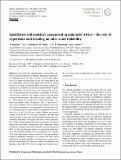| dc.contributor.author | Rinderer, Michael | |
| dc.contributor.author | Komakech, Hans | |
| dc.contributor.author | Seibert, Jan | |
| dc.date.accessioned | 2020-03-20T09:26:09Z | |
| dc.date.available | 2020-03-20T09:26:09Z | |
| dc.date.issued | 2015-08-10 | |
| dc.identifier.uri | https://doi.org/10.5194/hess-19-3505-2015 | |
| dc.identifier.uri | https://dspace.nm-aist.ac.tz/handle/20.500.12479/659 | |
| dc.description | This research article published by Copernicus Publications, Volume 19, issue 8, 2015 | en_US |
| dc.description.abstract | Soil and water management is particularly relevant in semi-arid regions to enhance agricultural productivity. During periods of water scarcity, soil moisture differences are important indicators of the soil water deficit and are traditionally used for allocating water resources among farmers of a village community. Here we present a simple, inexpensive soil wetness classification scheme based on qualitative indicators which one can see or touch on the soil surface. It incorporates the local farmers' knowledge on the best soil moisture conditions for seeding and brick making in the semi-arid environment of the study site near Arusha, Tanzania. The scheme was tested twice in 2014 with farmers, students and experts (April: 40 persons, June: 25 persons) for inter-rater reliability, bias of individuals and functional relation between qualitative and quantitative soil moisture values. During the test in April farmers assigned the same wetness class in 46 % of all cases, while students and experts agreed on about 60 % of all cases. Students who had been trained in how to apply the method gained higher inter-rater reliability than their colleagues with only a basic introduction. When repeating the test in June, participants were given improved instructions, organized in small subgroups, which resulted in a higher inter-rater reliability among farmers. In 66 % of all classifications, farmers assigned the same wetness class and the spread of class assignments was smaller. This study demonstrates that a wetness classification scheme based on qualitative indicators is a robust tool and can be applied successfully regardless of experience in crop growing and education level when an in-depth introduction and training is provided. The use of a simple and clear layout of the assessment form is important for reliable wetness class assignments. | en_US |
| dc.language.iso | en | en_US |
| dc.publisher | Copernicus Publications | en_US |
| dc.subject | Research Subject Categories::NATURAL SCIENCES | en_US |
| dc.title | Qualitative soil moisture assessment in semi-arid Africa – the role of experience and training on inter-rater reliability | en_US |
| dc.type | Article | en_US |

